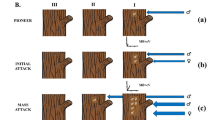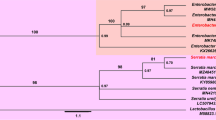Abstract
Cadavers of late instar Lymantria dispar (gypsy moth) larvae killed by the fungal pathogen Entomophaga maimaiga predominantly contain resting spores (azygospores). These cadavers frequently remain attached to tree trunks for several weeks before they detach and fall to the ground. Density gradient centrifugation was used to quantify resting spores in the soil and on tree bark. Titers of resting spores were extremely high at 0–10 cm from the base of the tree and the number decreased with distance from the trunk of the tree. Titers were also highest in the organic layer of the soil with numbers decreasing precipitously with increasing depth in the soil. While resting spores were obtained from tree bark, densities per unit area were much lower than those found in the organic soil layer at the base of the tree. Field bioassays were conducted with caged L. dispar larvae to compare infection levels with distance from the tree trunk as well as on the trunk. Highest infection levels were found at 50cm from the tree base with lowest infection on the tree trunk at 0.5 m height, although we expected the highest infection levels among larvae caged at the bases of trees, where highest spore titers occurred. Laboratory experiments demonstrated that L. dispar larvae exposed to resting spore- bearing soil at the soil surface became infected while larvae exposed to soil with resting spores buried at least 1 cm below the surface did not become infected.
Similar content being viewed by others
References
Andreadis, T.G. and R.M. Weseloh, 1990. Discovery of Entomophaga maimaigain North American gypsy moth, Lymantria dispar. Proc. Natl. Acad. Sci., U.S.A.87: 2461-2465.
Bell, R.A., C.D. Owens, M. Shapiro and J.R. Tardif, 1981. Development of mass-rearing technology. In: C.C. Doane and M.L. McManus (eds), The gypsy moth: research toward integrated pest management. USDA Forest Service Tech. Bull. 1584. pp. 599-633.
Byford, W.J. and L.K. Ward, 1968. Effect of the situation of the aphid host at death on the type of spore produced by Entomophthoraspp. Trans. Brit. Mycol. Soc.51: 598-600.
Doberski, J.W. and H.T. Tribe, 1980. Isolation of entomogenous fungi from elm bark and soil with reference to ecology of Beauveria bassianaand Metarhizium anisopliae. Trans. Br. Mycol. Soc.74: 95-100.
Dustan, A.G., 1924. Studies on a new species of Empusaparasitic on the green apple bug (Lygus communisvar. novascotiensisKnight) in the Annapolis Valley. Proc. Acadian Ent. Soc.9: 14-26.
Hajek, A.E. and R.A. Humber, 1997. Formation and germination of Entomophaga maimaigaazygospores. Can. J. Bot.75: 1739-1747.
Hajek, A.E. and D.W. Roberts, 1991. Pathogen reservoirs as a biological control resource: introduction of Entomophaga maimaigato North American gypsy moth, Lymantria dispar, populations. Biol. Contr.1: 29-34.
Hajek, A.E. and M. Shimazu, 1996. Types of spores produced by Entomophaga maimaigainfecting the gypsy moth Lymantria dispar. Can. J. Bot.74: 708-715.
Hajek, A.E., K.M. Tatman, P.H. Wanner and M.M. Wheeler, 1998. Location and persistence of gypsy moth, Lymantria dispar, cadavers containing Entomophaga maimaigaazygospores. Mycologia90: 754-760.
Hajek, A.E. and M.M. Wheeler, 1994. Application of techniques for quantification of soilborne entomophthoralean resting spores. J. Invertebr. Pathol.64: 71-73.
Hajek, A.E., R.A. Humber, J.S. Elkinton, B. May, S.R.A. Walsh and J.C. Silver, 1990. Allozyme and restriction fragment length polymorphism analyses confirm Entomophaga maimaigaresponsible for 1989 epizootics in North American gypsy moth populations. Proc. Natl. Acad. Sci., U.S.A.87: 6979-6982.
Ignoffo, C.M., C. Garcia, D.L. Hostetter and R.E. Pinnell, 1977. Vertical movement of conidia of Nomuraea rileyithrough sand and loam soils. J. Econ. Entomol.70: 163-164.
Keller, S. and G. Zimmermann, 1989. Mycopathogens of soil insects. In: N. Wilding, N.M. Collins, P.M. Hammond and J.F. Webber (eds), Insect-fungus interactions, Academic Press, London. pp. 240-270.
Kohnke, H. and D.P. Franzmeier, 1995. Soil science simplified, 4th edition. Waveland Press, Prospect Heights, IL.
Latteur, G., 1977. Sur la possibilité d'infection directe d'Aphides par Entomophthoraà partir de sols hébergeant un inoculum naturel. C. R. Acad. Sc. Paris Sér. D284: 2253-2256.
Liebhold, A.M. and J.S. Elkinton, 1989. Characterizing spatial patterns of gypsy moth regional defoliation. For. Sci.35: 557-568.
MacDonald, R.M. and J.R. Spokes, 1981. Conidiobolus obscurusin arable soil: a method for extracting and counting azygospores. Soil Biol. Biochem.13: 551-553.
Soper, R.S., M. Shimazu, R.A. Humber, M.E. Ramos and A.E. Hajek, 1988. Isolation and characterization of Entomophaga maimaigasp. nov., a fungal pathogen of gypsy moth, Lymantria dispar, from Japan. J. Invertebr. Pathol.51: 229-241.
Shimazu, M., C. Koizumi, T. Kushida and J. Mitsuhashi, 1987. Infectivity of hibernated resting spores of Entomophaga maimaigaHumber, Shimazu et Soper (Entomophthorales: Entomophthoraceae). Appl. Ent. Zool.22: 216-221.
Steinkraus, D.C., R.G. Hollingsworth and G.O. Boys, 1996. Aerial spores of Neozygites fresenii(Entomophthorales: Neozygitaceae): density, periodicity, and potential role in cotton aphid (Homoptera: Aphididae) epizootics. Environ. Entomol.25: 48-57.
Storey, G.K. and W.A. Gardner, 1988. Movement of an aqueous spray of Beauveria bassianainto the profile of four Georgia soils. Environ. Entomol.27: 135-139.
Weseloh, R.M. and T.G. Andreadis, 1997. Persistence of resting spores of Entomophaga maimaiga, a fungal pathogen of the gypsy moth, Lymantria dispar. J. Invertebr. Pathol.69: 195-196.
Author information
Authors and Affiliations
Rights and permissions
About this article
Cite this article
Hajek, A., Bauer, L., McManus, M. et al. Distribution of resting spores of the Lymantria dispar pathogen Entomophaga maimaiga in soil and on bark. BioControl 43, 189–200 (1998). https://doi.org/10.1023/A:1009933525540
Issue Date:
DOI: https://doi.org/10.1023/A:1009933525540




